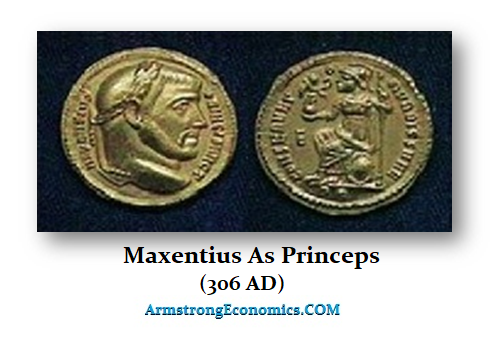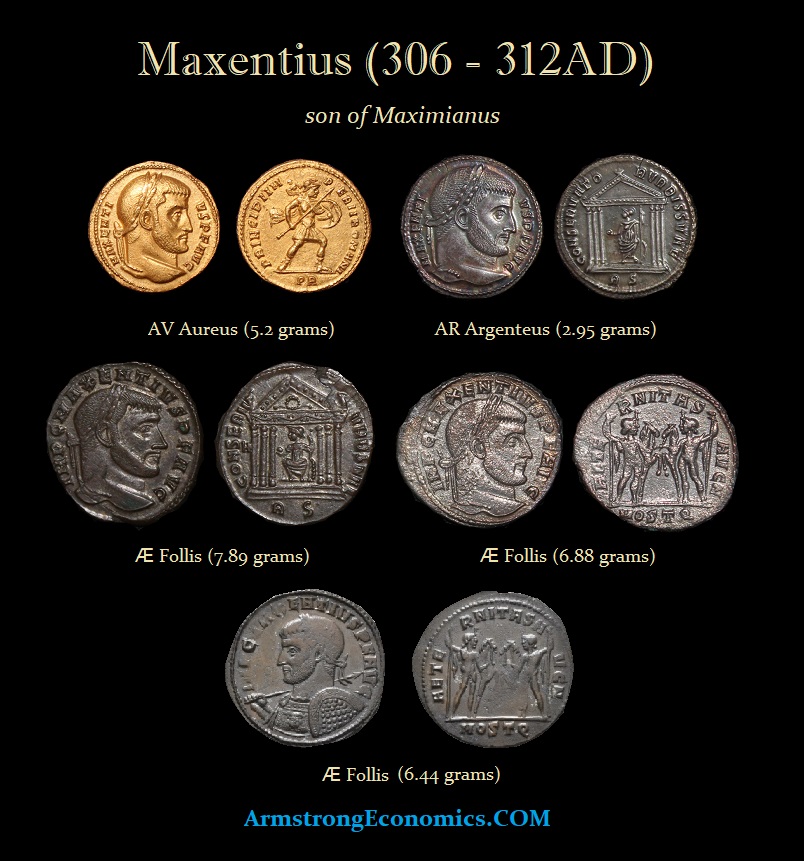Maxentius
306 – 312 AD
Son of Maximianus
Son-in-law of Galerius
Marcus Aurelius Valerius Maxentius was born in 279 AD, the son of the joint Emperor Maximianus with his wife Eutropia. Despite his birth status and his senatorial rank, Maxentius was passed over twice in the succession to the throne. In 305 AD, when both Diocletian and his father retired from office, Maxentius was passed over for the rank of Caesar, losing out to Galerius and Constantius I Chlorus (father of Constantine the Great). Despite being married to the daughter of Galerius, Valeria Maximilla, Maxentius was passed over a second time following the death of Constantius I when Severus II was raised to the rank of Augustus and Constantine was given the rank of Caesar.
After being passed over twice, Maxentius led a revolt in 306 AD in an attempt to claim what he believed to be his birthright to the throne. The reforms of Diocletian eliminated the special tax-free status enjoyed by Rome, thus creating an eager body of supporters for anyone who would restore the privileged status that Rome had enjoyed within the Empire. Thus, Maxentius’ revolt was very much one that drew its support based upon a tax revolt movement despite his personal ambitions. The domain of Maxentius, therefore, became Italy and North Africa.
Maxentius also found support among the old Praetorian Guard. This centuries-old elite unit of troops, which Augustus had established, had recently been replaced by Diocletian’s Scutarii, domestic, and the Jovians and Herculians with the intent of reducing the risk of mutiny or assassination, which had often emanated from inside the Praetorians throughout history stretching back as far as Sejanus under Tiberius. Therefore, Maxentius found yet another group of eager supporters for his cause.
On October 28, 306 AD, all of Rome rose in support of Maxentius, thereby proclaiming him Emperor. Maxentius quickly found additional supporters who rallied to his cause throughout Italy and North Africa due largely to the unpopular tax reforms imposed by Diocletian and his father. Galerius, the senior Augustus at the time, refused to recognize Maxentius’ claim and ordered Severus II to march on Rome.
Severus’ efforts to confront Maxentius were met with serious problems. Maxentius was gathering support from the soldiers who had fought under his father, and many came out of retirement to aid his son in the struggle against Severus. The popularity of Maxentius began to turn even the troops under Severus’ command and finally, his entire effort simply collapsed. The failure of Severus had a severe impact upon Galerius forcing him to take to the field personally. The same fate awaited Galerius as his support quickly vanished.
Constantine I the Great made attempts to exploit the situation. Realizing that Maxentius held great popular support, Constantine sought and received an alliance. In return for Constantine’s recognition of Maxentius’ status as legal heir, Maxentius gave his sister (daughter of Maximianus) Fausta in marriage to Constantine I to seal the pact. But the relationship between Maxentius and Constantine was certainly shaky at best, even from the start.
Following the defeat of Galerius, Spain declared itself in favor of Maxentius. Jealous of his own son, Maximianus came out of retirement and sought to regain the glory and power of the past. Maximianus thus launched his own revolt in 308 AD. His rise to power the second time was brief, as his revolt was quickly crushed by Constantine the Great. Nonetheless, the rise of Maximianus did have an effect upon Maxentius and began a declining trend of popular and military support for his cause.
In 308 AD, at the conference of Carnuntum, Maxentius was declared a public enemy, and Galerius succeeded in stripping him of all his titles. In North Africa, another revolt broke out led by the Prefect of Alexandria –Domitius Alexander. It was Alexander who cut the vital grain supply to Rome from Egypt. Alexander’s actions had a devastating impact upon Rome and thus the popular support of Maxentius himself. By 311 AD, the situation had become serious as starvation threatened the citizens of Rome. Maxentius was forced to send Rufius Volusianus against the rival usurper Alexander to retake the province and restore the grain supply. Victory was easy; Alexander was victorious, and Carthage was made to suffer dearly for its insurrection.
Constantine I used this time to move against Galerius, defeating him in 311 AD. Constantine I then formed another uneasy alliance, this time with Licinius against Maxentius in Italy and Maximinus II Daia, nephew of Galerius, in the East. The shrewd Constantine I, realizing that Maxentius was vulnerable, decided to march across the Alps in 312 AD.
It was a risky venture since Maxentius’ forces still greatly outnumbered those of Constantine I despite his setbacks and the death of his father in 310 AD, which was most likely on Constantine I’s orders. Descending through the Genevre Pass, Constantine entered Italy. Several battles were fought as Constantine neared Rome itself. The final battle came on October 28th, 312 AD, at Milvian Bridge. During this battle, Constantine I had a vision of Christ and marched against Maxentius under the Christian symbol of the cross.
Historians have written much about the Battle of Milvian Bridge, which has been characterized as the battle between Christianity and Paganism. As Maxentius’ troops began to retreat across a temporary bridge constructed upon boats, he fell into the water when the bridge collapsed, along with thousands of his troops. His armor proved too heavy, and thus, he drowned in the waters of the Tiber.
Despite the biased historical accounts, the Battle of Milvian Bridge was less of a battle between Christianity and paganism as it was a battle for power and control. While Maxentius may have been a pagan, he did not persecute the Christians and in fact built the first Christian church in Rome. As for Constantine I himself, he would prove to be a man who rarely kept his word and often displayed ruthless tactics to gain sole domination of the Roman Empire. Nonetheless, no matter how unsuitable Constantine I may have been in terms of Sainthood, it was this battle which changed the course of the Roman Empire transforming it into a new state where Christianity became the religion of the state.
Certainly, Christianity had already won a vast segment of the population long before Constantine I came on the scene. Whether Constantine I was a Christian first or just another ambitious man in a long line of ambitious rulers remains to be proven. It is more likely that Constantine, seeking support, saw a majority of religious backing among the Christians, which he perhaps transformed into a holy war against the pagan Maxentius or the fact that there were many Christians within the ranks of Maxentius’ army and displaying Christian symbols would have disoriented his troops.
Perhaps Maxentius exploited Diocletian’s unpopular tax reforms to further his ambitions for power. Apparently, Maxentius’ troops retreated to the Tiber River, and in the chaos, Maxentius is said to have fallen into the River and drowned. His body was found the next day and paraded through the city. Yet, the regalia of Maxentius was recently discovered in 2006 and buried on the Palatine Hill to prevent Constantine I from winning the prize. It is the only regalia of a Roman Emperor to have survived. The most fascinating aspect of this is the top is a Blue Orb representing the ROUND globe of the Earth – not flat.
Monetary System

Mints: Aquileia, Carthage, Ostia, Rome, Ticinum, Treveri
Obverse Legends:
As Princeps 306 AD
MAXENTIVS PRINC INVICT
As Caesar 306 AD
MAXENTIVS NOB C
M AVR MAXENTIVS NOB CAES
As Augustus 306 – 312 AD
MAXENTIVS P F AVG
IMP C MAXENTIVS P F AVG
DENOMINATIONS
As Princeps (306AD)
AU Aureus (5.20 grams) (Extremely Rare)
AR Argentius (2.95 grams)
Æ Follis
As Caesar (306AD)
AU Aureus (5.20 grams) (Extremely Rare)
Æ Follis
As Augustus (306-312AD)
AU DOUBLE Aureus (10.00 grams)
AU Aureus (5.20 grams)
AU Aureus [Facing bust] (5.20 grams)
AR Argentius (2.95 grams)
Æ Follis
Æ ½ Follis
Æ ¼ Follis









